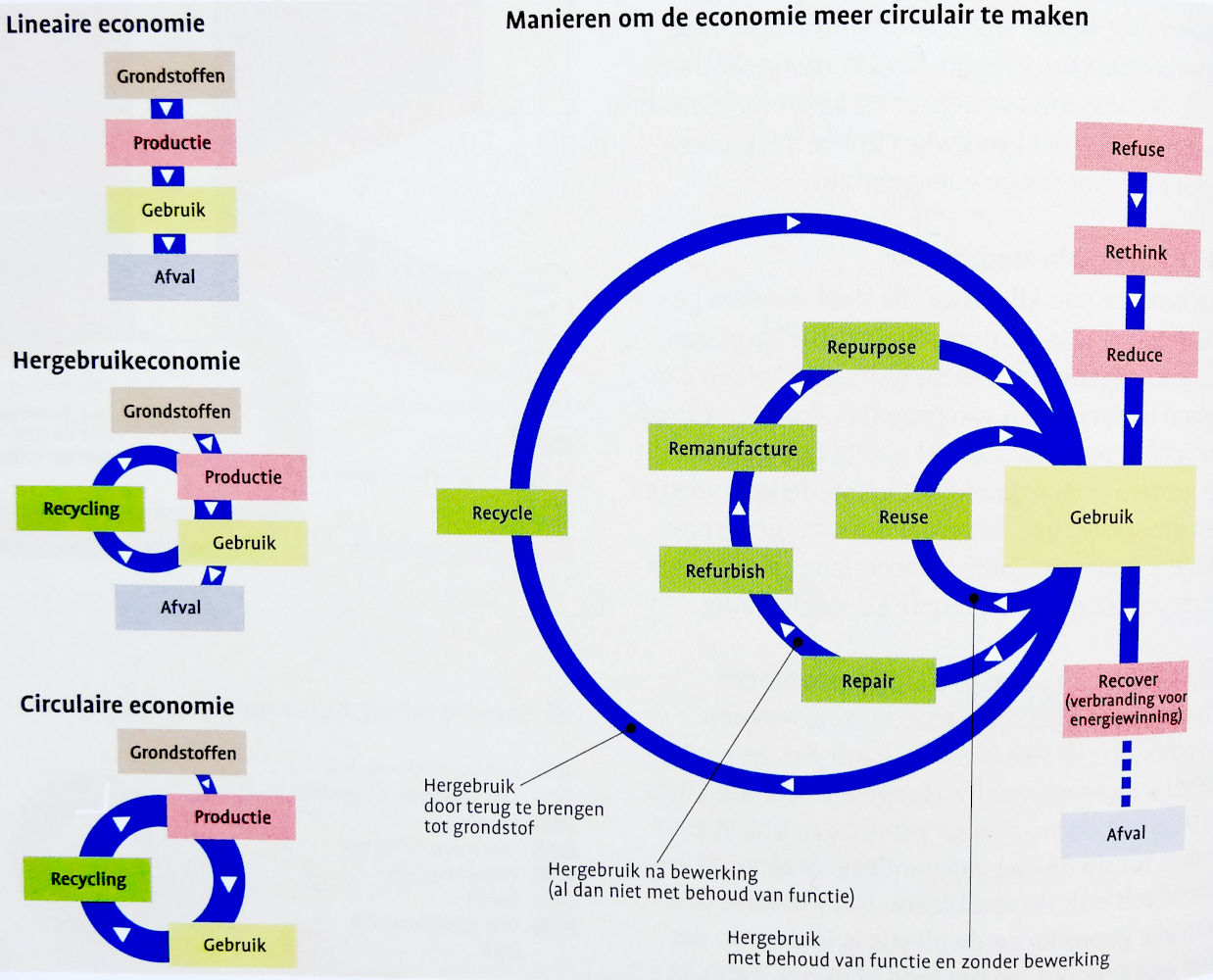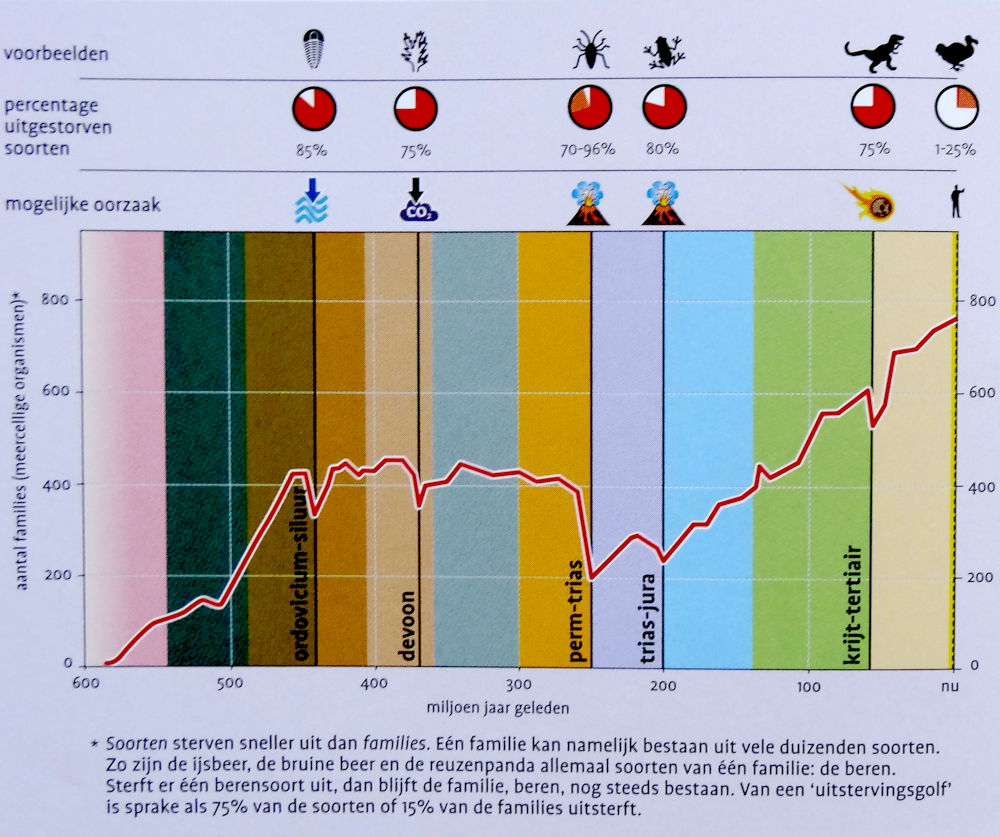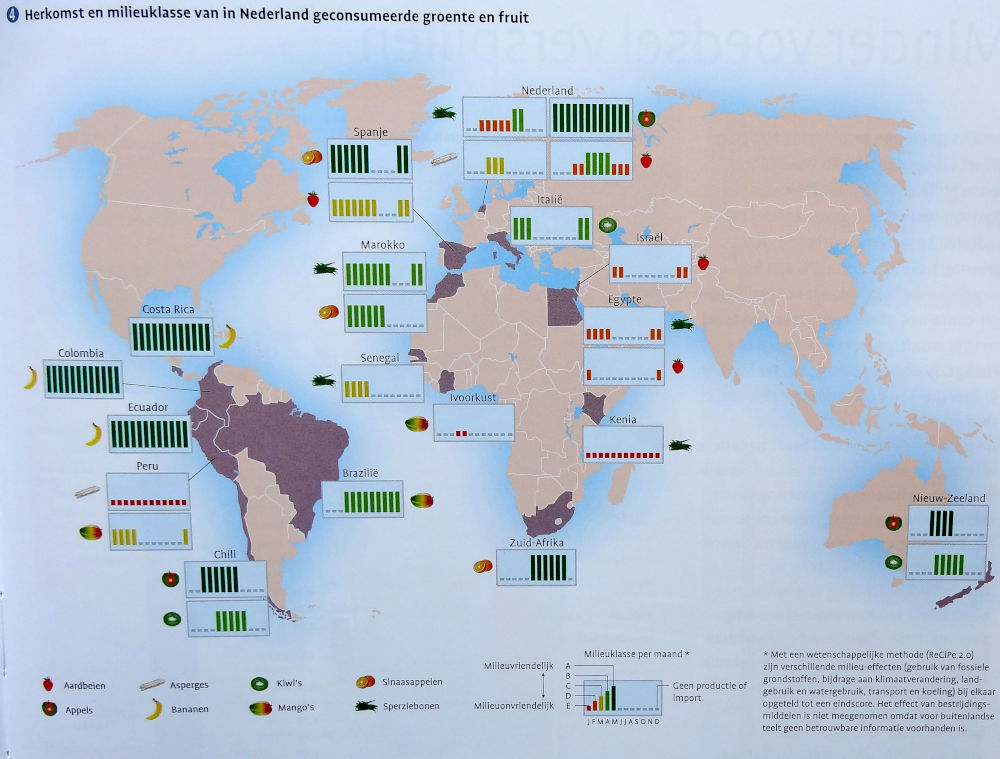Encyclopedia of sustainability
The Bosatlas, that's nostalgia for me. I believe I am the generation of edition 54. However, this is the 1st edition on sustainability (Oct. 2019). It contains all the commonly used pictures and sankeys about climate change and raw materials - from IPCC and NASA to the IEA - making it perfect for general reference and education. In the preface it becomes clear that we are dealing here with a broad definition of "sustainability" and not the distorted political/construction world definition of "something that lasts for a long time". The classic tripartite division of people planet prosperity (prosperity people and the living environment) is therefore immediately discussed.
Introduction

Pages 8-9: how much can the earth handle?
In the introduction we immediately see (page 9) subjects in which improvements are needed this century. After a - to me startling - summary of large-scale pollution and eradication over the centuries, the UN sustainable development goals are discussed. Babette Porcelain's book ("Hidden Impact") gave me wonderful coherence and only a few selective possible solutions, while this Bosatlas also unambiguously says a lot about the solutions. For example, on pages 14-15 there is literally a range of solutions, both ecological and technological. From "no meat a few days a week", "no air travel and cruises" and "less fertilization" to "to Mars for new raw materials", "battery parks" and a few (probably hypothetical) technological solutions.
Climate

Pages 30-31: how do you reduce your climate footprint?
So this first chapter contains those "mandatory" infostatics that you really should have seen if you're reading about sustainability and climate change. A missed opportunity is that only four recent disasters are listed on pages 24-25, while to my knowledge the full truth is that there are annual There have been about five times as many major disasters since 1970. Usually, the danger of flooding in the Netherlands only concerns the sea rise (25 to 80 cm until 2100), here you can also see various statistics per province, such as land subsidence. Dared to discuss the Climate Act (pp. 28-30) -just 2 months before the press- as the Green Deal and other legislations are rapidly replacing each other. In few other sources I found the clarity about the climate footprint diminishing as on pages 30-31: it is immediately clear why you should eat vegetarian or - like me - really don't want to fly anymore.
Energy

Page 41: Coal-fired power stations and future wind farms
All kinds of energy flows are discussed here, especially industrial ones. We see on page 39 where how much gas is used, and on page 41 where which coal-fired power stations are located and where large wind farms will be located. Tucked away in a paragraph (p. 40) is something important that I use in almost every course self-sufficient off-grid also emphasize: if you only use energy if it is available (solar/wind), then you do not have a (major) storage problem - also industrially, energy may only be used if there is a supply of renewable energy. Now we just have to wait until politicians understand this and make the electricity really expensive at night... Fortunately, when defining future energy flows (page 42), there is emphatically no oil, coal and hardly any gas left.
Raw materials

Page 54: Circular economy
The chapter on raw materials is wonderful material for school assignments. The author who writes on page 50 that organic raw materials for clothing are no more sustainable than regular raw materials, has done his homework (for your information: the only thing that helps is buying less new clothes). Where we use a film for our own courses for the bizarre amount of raw materials for a smartphone, they are clearly shown here on pages 58-59. So, maybe you want to wait a few more years before buying a new smartphone (or just buying a new battery)?
Nature Water Industry

Page 62: The Sixth Extinction Wave in Earth's History
A lot of basic knowledge about nature and the loss of biodiversity is also beautifully arranged. How about we are probably now causing the sixth extinction wave (p. 62), and that 30 to 90% of the species in the Netherlands are threatened with extinction? The honesty behind "as much natural fertilization as possible, less fertilizer" on page 72 about circular agriculture and biodiversity makes me happy. As a permaculture teacher I also see a lot of permaculture, such as that all ditches and ditches contain 96% of the biodiversity.
The chapter on water states that 9 million Dutch people now live in areas subject to flooding. Worldwide, as many as 800 million people now live in areas where sea levels are likely to rise half a meter or more (p. 78). (And a typo on page 77: we use on average not 4,100 but 41,000 liters of water per person per year). There is even more about industry and possible technical matters such as CO2 storage, hydrogen work in Zeeland, sustainable chemistry in the north and finally CO2 neutral steel production (after all, the book is also sponsored by TaTa steel).
Food

Page 105: origin of our green and fruit is certainly not only the Netherlands
Once again, this chapter does not only look at CO2, but also at working conditions, biodiversity, etc. (page 104). As expected, cheese and meat come out on top in terms of environmental impact. I sometimes hear someone claim that the Netherlands is self-sufficient in food; p. 105 quickly wipes that off the table. The infographics on page 109 are crystal clear: we really need to eat less meat to reduce our food footprint. The forest atlas is also clear about sustainable dairy production, even if that is bad news for farmers: only cattle feed from their own land (110-111), and therefore: less cattle.
I am missing information in this chapter about the great decline in seed diversity and seed traders. And I also regret that the publisher uses the dated disc of five on pages 108-109, which is really only for Dutch people and politicians who look no further than old scientific studies and sponsorship of the industry (why is milk and red meat in the slice of five at all?).
... and much more
Where the beginning excels in clarity, in my opinion it is a lot less at the end. In the chapter on transport I am less happy about the unrealistic alternatives to flying, probably because they hardly exist. And the chapter on building contains a remarkable number of optimistic infographics about green gas (pp. 130-131), while there they only talk about money and not about feasibility (there is certainly not enough biogas and enough green electricity for hydrogen) - maybe GasTerra's cooperation played a role. That page should contain an explanation of a large solar boiler -which can take care of the heat demand for 6 to 8 months a year.
Pages 134-135 about circular construction really fall short and talk almost only about the reuse of building materials. What is missing first of all is that concrete/cement gives the most CO2 load when building a building, and secondly that this concrete/cement pollution can be prevented by building differently with, for example, straw bales construction, lime hemp and CLT. Even skyscrapers are being built from CLT, and flats with straw bale construction.
Lijn43: Forest atlas of sustainability. Noordhoff Atlas Productions, Groningen 2019. 151 pag. ISBN 978-90-0112-028-3. Price E30,-.
With the exception of a few caveats, I think this is a highly recommended book for anyone who does anything with sustainability, and for anyone who has never delved into it. In any case, the extensive explanation makes it clear - in very neutral terms - that the need for action is very great.
Check out our popular course Selfsufficient Off-grid.
